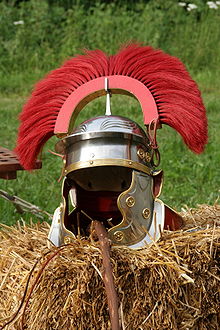Cassis (helmet)
Along with Galea, cassis was the collective Latin name for helmets. Originally, these were round, simple helmets of Etruscan origin, which the legionaries probably wore in the early days of the Roman Empire .
In the later centuries the helmet of the Montefortino type, probably from the Celtic culture, was worn. But there were also helmet forms with some Greek influence in the Roman army . In the course of the 1st century, another type of Celtic helmet was adopted from Gaul , which was further developed into the Gallo-Roman helmet type and divided into many subgroups (these include, for example, the types Hagenau / Coolus and Weisenau ). During the 3rd century, which was marked by internal and external instabilities, the development of the Gallo-Roman helmets suddenly came to a standstill. The cultural influence of the East, which shaped the next centuries, and the high material costs that were previously required for helmet production, brought it among other things. a. with it that completely new, cheaper helmet types were given preference. The Roman infantry and cavalry helmets that were now becoming standard probably had Sassanid and Persian models. For the first time, there are also helmets with the typically “ Norman ” looking nose protection.
With the advent of Christianity as the state religion also crosses were in the helmet hallmark . In addition, representations of crescent moons and implied eyes were added. More recently, comb helmets and clasp helmets have been used, the latter often being equipped with a loosely falling horsehair bush.
Manufacturing
→ Main article: Making Roman helmets
Roman helmets were initially made of bronze and later mainly made of iron. The domes of the bronze helmets from Republican times were often cast , hardened by forging and brought into their final shape. In addition, cheek flaps, eyelets and decorations were attached. Later bronze helmets and iron helmets made of thick sheet metal were driven into shape . Some of the surfaces were elaborately designed, tinned or decorated with non-ferrous metal or silver sheets.
literature
- Antique helmets. Collection Lipperheide and other holdings of the Antikenmuseum Berlin (= Römisch-Germanisches Zentralmuseum. Monographs 14). Publishing house of the Roman-Germanic Central Museum, Mainz 1988, ISBN 3-88467-019-0
